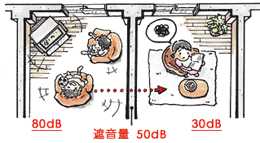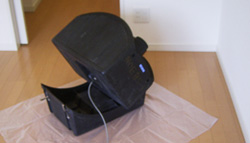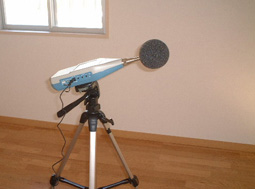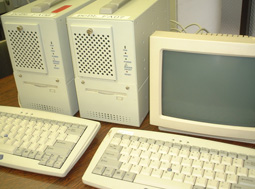![]()
 We sometimes receive inquiries like this from the phone or by email.
We sometimes receive inquiries like this from the phone or by email.
Efficiency between a room and the room next door, and to measure the volume of sound which is coming from the room next door.
When measuring the sound insulation efficiency between a room and the room next door, we measure the sound insulation efficiency (measurement of the sound pressure level difference between both rooms) the wall, the floor and the ceiling using a measurement method decided by JIS (Japanese Industrial Standards), and then evaluate the result in an applied class related to the average sound pressure level difference between both rooms which is also decided by the architectural institute of Japan. This applied class is separated into special grade, 1st grade, 2nd grade and 3rd grade. For instance, 1st grade indicates the edesirable efficiency level recommended by the Architecture Institute of Japan.
When measuring the volume of sound coming from the room next door, since we don't know where the sound occurs, we can set up measurement equipment to record unattended measurement of the noise. However, because the measurement method for daily life noise such as peoples voice or the sound of a TV has not been provided by the architecture institute of Japan, these are difficult problems that we cannot evaluate the measurement result as is, in the applied class relating to the room noise by the architecture institute of Japan (the noise from facilities or equipment in that building, or the traffic noise from outside can be evaluated). Yet, the result of the volume of daily life noise that we have measured, or what time and how many times it happens are objective data which has been key for us in solving the noise problem.
The measurement in which we investigate how well the boundary of the wall or the boundary of the floor between the units is sound insulated using a sound insulation efficiency measurement. The measurement is carried out on the basis of JISA1417:2000 "Field measurement of airborne sound insulation" or the recommended measurement standard "Field measurement of airborne sound insulation" by the Japanese Architecture Society.
When taking the measurement, we placed a speaker for testing the tone in the room next door (sound source side), that produced the octave band noise from the low-pitched sound to the high pitched sound examining the sound, and measuring the sound pressure level on the sound source side of and the sound receiving room with a sound level meter. The measurement result is averaged depending of the frequency in each of sound source and sound receiving side, and the difference is considered to be sound insulation efficiency (sound pressure level difference between two rooms). This measurement result can be evaluated in an applied class related to the average sound pressure level difference between two units by the architectural institute of Japan.
The cost of performing this measurement will depends upon the area, the number of places that will need to be measured and at what time the measurement can be conducted. For instance, if the measurement is going to be conducted in Tokyo Ward 23, the cost would be more than ¥200,000 including a report. Please contact our acoustic solution division (81-3-3634-5300) for more details.


We have a measurement system which is able to answer the demand of investigating noise unattended for a long period of time. This is an effective measurement system when a client is troubled by daily life noise and squeaks and rattles. This system will confirm the size, number of times and when the sound occurred, against noise which may occur any time.
To setup the measurement indoor, we placed a noise meter in the room, and then we will record and save the generated sound to a pc. The noise can be measured for a week or more using the automatic recording function (unattended) and continuous measurement can be done depending on the size of the hard disk.
After taking the measurement, we will extract the highly generated sound source from the lower ones from the recorded data in the computer to analyze the volume and the time of the sound. Also, we can analyze the frequency response of the sound. Furthermore, listening to the recorded sound is possible. For that reason sometimes we invite the people who are having the specific noise problem to come to our audiometric test room to listen together to confirm the problem.
The cost of performing this measurement will depend upon the area and the measurement time frame and etc. Please contact our acoustic solution division (03-3634-5300) for more details.


